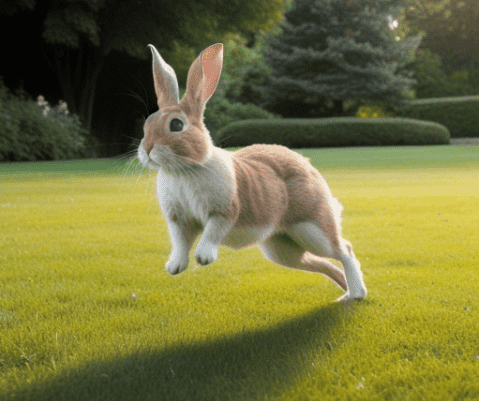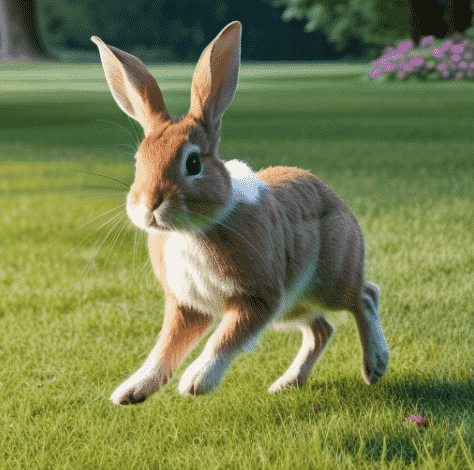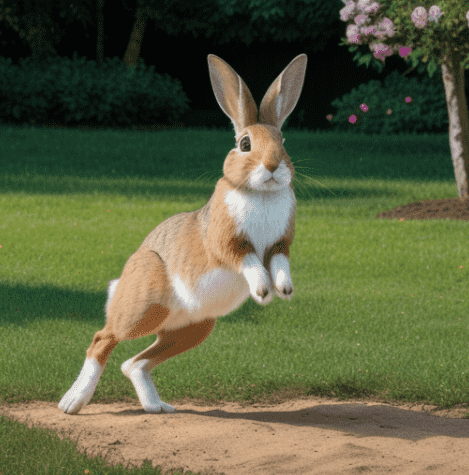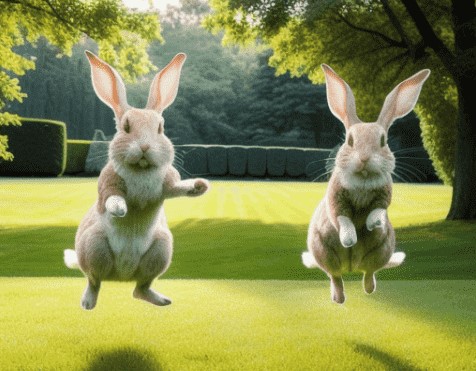Rabbit jumping, known as rabbit hopping or Kaninhop, has gained global popularity.
This sport, originating from Sweden in the early 1980s, involves rabbits jumping over obstacles. It showcases the agility and athleticism of rabbits.
Not just a spectacle, rabbit jumping serves as an excellent exercise for these creatures. It aids their physical health and offers mental stimulation.
As we dive into the realm of rabbit jumping, we’ll discuss the various aspects of this activity.
From understanding their natural athleticism to training for rabbit jumping, we’ll cover it all. In the upcoming sections, we will also answer your question ‘How high can rabbits jump”. So, let’s get into it.
Table of Contents
The Natural Jumping Abilities of Rabbits

Rabbits are natural jumpers, a quality that helps them survive in the wild. Predators often find it difficult to catch these quick and elegant creatures. Jumping, for rabbits, is not just a form of exercise but a survival mechanism hardwired into their biology.
It’s worth noting that rabbits’ hind legs are longer and stronger than their front legs. This natural ability gives them the ability to jump so high and fast. “How high can rabbits jump?” is a common question when it comes to rabbits. Well, from standing still, a rabbit can leap forward up to 2 meters and jump as high as a meter.
Remember, each rabbit is unique, and their jumping ability can differ based on factors like breed, age, health, and individual physical condition. Thus, while some rabbits can easily clear a high jump, others prefer to keep their leaps closer to the ground.
Vertical and Horizontal Jumping Capabilities of Rabbits
Rabbits are capable of some truly incredible feats when it comes to both vertical and horizontal jumps. On average, a rabbit can jump vertically up to 1 meter. Horizontal jumps are even more impressive. As for horizontal leaps, rabbits can cover a distance of 2.7 to 3 meters in a single leap.
Now you know how high rabbits can really jump.
The Rabbit High Jump Official World Record
On the competitive stage, rabbits have made some amazing records. The official world record for the highest rabbit jump stands at 107 centimeters.
This feat was achieved by a rabbit named Holloway Ch Tennessine in March 2023. Marie Kozubková from the Czech Republic owns Tennessine. This remarkable rabbit achieved an impressive feat in high jumping, setting a new record for rabbits worldwide.
Measuring Your Rabbit Jumping Heights
Determining your rabbit’s jumping height is interesting and valuable, especially if you’re considering rabbit show-jumping. But, the process must be safe and enjoyable for your rabbit.
For the measurement, you need to create a jump setup. Use a smooth bar and adjustable supports. Ensure the bar can easily fall if your rabbit doesn’t clear the height. This way, there’s less chance of injury.
Begin with the bar at a low level. Encourage your rabbit to jump over using a gentle guide, like a rod or pointer. Never use force or cause stress to your rabbit. Slowly increase the height, noting the highest level your rabbit can clear without knocking the bar off.
This method gives a reliable measure of your rabbit’s jumping capability.
Natural Behaviors of Rabbits Related to Jumping

Rabbits are outstanding jumpers. Their athletic leaps are not just for show but are deeply rooted in their natural behaviors, essential for survival and social communication.
Instinctual Defense Mechanism
When facing threats, a rabbit’s jump is a crucial defense mechanism. They use their sturdy hind legs to perform a ‘binky,’ a high, quick jump that often involves a mid-air twist.
Rabbits use this quick and unpredictable move to confuse predators, helping them escape safely.
Jumping to Escape Predators
Jumping plays an integral role in a rabbit’s plan to escape predators. Their strong hind legs provide the power for long leaps, enabling swift directional changes that make them harder to catch.
They can also change directions quickly mid-jump, making it challenging for predators to predict and capture their movements.
Social Interaction and Communication
Beyond survival, jumping serves as a communication tool in the rabbit community. A ‘joy jump,’ characterized by a high leap often accompanied by twists and kicks, signals happiness or excitement to fellow rabbits. This form of social interaction shows the importance of play and positive emotion in their lifestyle.
Factors Affecting Rabbit Jumping Heights
In the world of rabbits, the jumping ability can differ. Several factors can influence how high and how far a rabbit can leap.
Genetic
Genetics plays a pivotal role in a rabbit’s jumping prowess. A lineage of high jumpers might pass those traits down to the next generations. It’s the genes that mainly dictate the physical capabilities of these creatures.
Breed
Rabbits come in various breeds, each possessing unique characteristics. Some breeds are known for their skill and strength, making them more adept at jumping than others. Flemish Giants, for example, are large but less inclined to jump high, while smaller breeds, such as the English Spot, are more active and capable jumpers.
Age
Age is a considerable factor in determining the jumping capabilities of a rabbit. Young rabbits, generally those under two years old, are full of energy and agility. Their youthful strength allows them to jump quite higher and more often.
As rabbits age, their energy levels decline. You may notice a reduction in their jumping height and frequency from around the age of four. Older rabbits, generally over six years, may not attempt higher jumps.
Size Variations
Size is another major determinant. Larger rabbits may have powerful hind legs to support their weight but might not jump as high as their smaller breeds. Smaller breeds tend to be more active, often leading in the race of jumping heights.
Thus, the jumping heights of rabbits aren’t accidental. They hinge upon genetic, breed-specific, age-related, and size variation factors. Knowing these can help you understand your pets better, encouraging a more supportive environment for them.
What Obstacles Can Rabbits Overcome?
Earlier, we mentioned how high rabbits can jump; now what about obstacles? We will also answer a common curiosity: How high can a rabbit jump over a fence? Rabbits are active creatures. Their natural environment conditioning them to navigate through a variety of obstacles. Their powerful hind legs and active bodies can handle various physical barriers.
Let’s get into some common obstacles that might come across a rabbit’s path and how they manage to overcome them:
- Fences: A rabbit can leap over fences, particularly those under a meter high. It is a common practice among rabbits in the wild to jump over barriers to access food or escape threats.
- Barriers or Low Walls: Low walls and barriers do not hinder the active and energetic rabbit. They can clear these with a hop and a jump, quickly moving on to their destination.
- Stairs and Steps: Rabbits can jump stairs and steps. With their powerful hind legs, they can easily hop up stairs, steps, and ramps.
- Garden Borders: Rabbits are known for their love of gardens. They can effortlessly leap over garden borders or low fences to enjoy the lush greenery.
- Natural Obstacles: In the wild, rabbits are used to jumping over natural obstacles such as fallen logs, small ditches, or even low bushes. This skill helps them escape predators and navigate their environment quickly and precisely.
Rabbits are exceptionally fast due to their strong hind legs. Their natural jumping abilities are outstanding. They can overcome challenges you may not have expected. So, when planning your bunny environment, consider their unique athletic abilities.
Can I Teach My Rabbit to Jump Over Obstacles?

Teaching your rabbit to jump over obstacles is possible. It can be an entertaining and fun activity for you and your pet. Rabbits have a natural propensity for jumping, and their active bodies are well-equipped for this task. You can guide your rabbit through various hurdles with the right training approach.
Patience and positive reinforcement are key in this process. Start with small, low obstacles and gradually increase the height and complexity as your rabbit gets comfortable.
Don’t forget to reward your rabbit’s successful leaps with treats or affection to reinforce the behavior. Remember, though, not to push your rabbit beyond its comfort zone. Safe and happy hopping should be your ultimate goal.
Remember to keep the training sessions short and fun. Over time, your little jumper will amaze you with what it can do!
Always ensure the safety of your rabbit during these sessions. If you’re not sure about something, consulting with a vet or a professional rabbit trainer is a good idea.
Training and Enrichment for Rabbit Jumping
Training your rabbit to jump can be an engaging and fun activity. It involves practice and patience but can increase bonding and healthier habits.
Exercises and Techniques for Enhancing Jumping Abilities
Developing your rabbit’s jumping ability begins with simple exercises. Introducing toys at different heights encourages natural jumping instincts. As their skills improve, increase the height slowly, ensuring it’s always a fun and comfortable experience for your rabbit.
Enrichment for Mental Stimulation
A mentally stimulated rabbit is a happy bunny. Incorporate toys and puzzle feeders and change their environment to keep your bunny’s mind sharp. This enrichment can lead to improved physical abilities, including jumping.
High Jump Rabbit Competitions
High jump competitions for rabbits, often known as Kaninhop, allow your rabbit to showcase their skills. These events emphasize safety and fun, allowing your rabbit to behave naturally in a supportive environment. These competitions are not just about winning but enhancing your rabbit’s physical and mental health.
Conclusion
Rabbits are born to jump. It’s in their nature and helps them survive. But how high or far they jump depends on age, size, breed, and genes.
You can help your rabbit jump better with safe, fun training. But take it slow to avoid hurting or stressing your pet.
Remember, each rabbit is different. So, learn about your rabbit’s jumping skills to give them the best care. Your new understanding can help you make their world more active and fun.
Now, use your knowledge of how high a rabbit can jump to create an active environment for your furry pet.
FAQs
Can rabbits jump higher than cats?
Rabbits and cats have impressive leaping abilities. While some rabbits can jump high, cats generally jump higher due to their flexible spine and strong hind legs.
Can a rabbit jump out of a cage?
Rabbits can jump out of a cage if the walls aren’t high enough or if there is no roof. It’s crucial to ensure the cage is secure and suitably sized to prevent escape and to protect your rabbit’s safety.
Can a rabbit live alone?
A rabbit can physically survive alone, but it’s not ideal. Rabbits are social animals and usually live better with company. If a second rabbit isn’t an option, you can fill the gap by having plenty of interaction with your rabbit.
How do I know if my rabbit is sad?
If your rabbit is sad, they might show signs like hiding more, not eating, or not showing interest in activities they used to enjoy. Changes in their grooming habits and a drop in energy levels can also show that your rabbit is not feeling well.
Alina Hartley is a small-town girl with a ginormous love of bearded dragons. It all started with Winchester, a baby bearded who was abandoned at the shelter by his former owners because of a birth defect that caused one front leg to be shorter than the other. Alina originally went to the shelter looking for a guinea pig, but one look at Winchester and it was love at first sight. From that day on, Alina has dedicated her life to learning everything she can about bearded dragons. She loves helping new beardie parents start their incredible journey with these magnificent reptiles.
Follow her on:
LINKEDIN
TWITTER.
Read her latest articles HERE
Learn more about her HERE.

